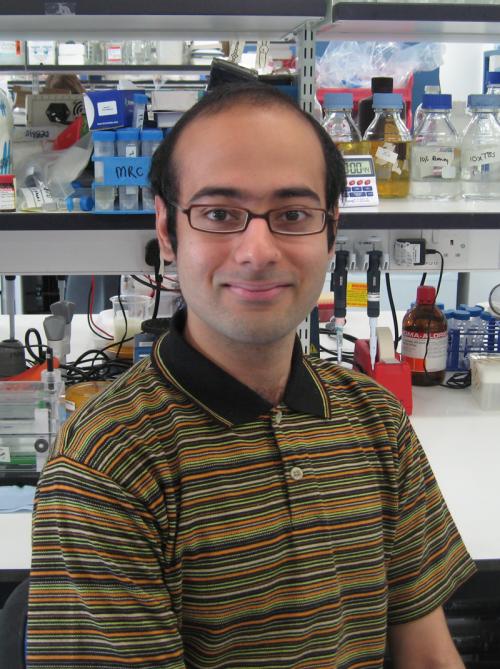
Sourav Banerjee Publishes paper describing first selective NUAK inhibitors
NUAK1 and NUAK2 are members of the AMPK family of protein kinase that are activated by the LKB1 tumour suppressor kinase. Recent work suggests they play important roles in regulating key biological processes including Myc driven tumourigenesis, senescence, cell adhesion and neuronal polarity.
In a major Collaboration with Sara Buhrlage, Nathanael Gray, and several of their colleagues at the Dana Farber Cancer Institute, Sourav Banerjee working in Dario Alessi's lab has published a paper reporting on two compounds termed WZ4003 and HTH-01-015 that are highly selective NUAK isoform inhibitors.
Sourav found that WZ4003 inhibited both NUAK isoforms (IC50 for NUAK1 20 nM and NUAK2 100 nM), whereas HTH-01-015 inhibits only NUAK1 (IC50 100 nM). These compounds display extreme selectivity and do not significantly inhibit the activity of 139 other kinases tested, including 10 AMPK family members. WZ4003 and HTH-01-015 inhibited the phosphorylation of the only well-characterised substrate namely MYPT1 that is phosphorylated by NUAK1 at Ser445.
Sourav also identified a mutation (A195T) that does not affect basal NUAK1 activity but renders it ~50-fold resistant to both WZ4003 and HTH-01-015. Consistent with NUAK1 mediating phosphorylation of MYPT1 he found that in cells overexpressing drug resistant NUAK1[A195T], but not wild type NUAK1, phosphorylation of MYPT1 at Ser445 is no longer suppressed by WZ4003 or HTH-01-015.
Sourav also demonstrated that administration of WZ4003 and HTH-01-015 significantly inhibited migration and proliferation of cells to a similar extent as knock-out of NUAK1.
Given the very high similarity of the catalytic domains of AMPK family kinases, it is likely that these kinases will phosphorylate non-physiological substrates normally phosphorylated by other family members. The identification of highly specific NUAK inhibitors offers encouragement that it will be feasible to develop specific inhibitors of all AMPK family inhibitors.
Sourav's data establish that HTH-01-015 and WZ4003 comprise useful tools for probing the physiological functions of the NUAK isoforms. To read a copy of Sourav's paper please click here.
Sourav also needs to be congratulated for very recently successfully defending his PhD thesis that was examined by two AMPK grand masters namely David Carling and Grahame Hardie. Sourav has one more paper to write up before moving to the USA to undertake postdoctoral research.
In a major Collaboration with Sara Buhrlage, Nathanael Gray, and several of their colleagues at the Dana Farber Cancer Institute, Sourav Banerjee working in Dario Alessi's lab has published a paper reporting on two compounds termed WZ4003 and HTH-01-015 that are highly selective NUAK isoform inhibitors.
Sourav found that WZ4003 inhibited both NUAK isoforms (IC50 for NUAK1 20 nM and NUAK2 100 nM), whereas HTH-01-015 inhibits only NUAK1 (IC50 100 nM). These compounds display extreme selectivity and do not significantly inhibit the activity of 139 other kinases tested, including 10 AMPK family members. WZ4003 and HTH-01-015 inhibited the phosphorylation of the only well-characterised substrate namely MYPT1 that is phosphorylated by NUAK1 at Ser445.
Sourav also identified a mutation (A195T) that does not affect basal NUAK1 activity but renders it ~50-fold resistant to both WZ4003 and HTH-01-015. Consistent with NUAK1 mediating phosphorylation of MYPT1 he found that in cells overexpressing drug resistant NUAK1[A195T], but not wild type NUAK1, phosphorylation of MYPT1 at Ser445 is no longer suppressed by WZ4003 or HTH-01-015.
Sourav also demonstrated that administration of WZ4003 and HTH-01-015 significantly inhibited migration and proliferation of cells to a similar extent as knock-out of NUAK1.
Given the very high similarity of the catalytic domains of AMPK family kinases, it is likely that these kinases will phosphorylate non-physiological substrates normally phosphorylated by other family members. The identification of highly specific NUAK inhibitors offers encouragement that it will be feasible to develop specific inhibitors of all AMPK family inhibitors.
Sourav's data establish that HTH-01-015 and WZ4003 comprise useful tools for probing the physiological functions of the NUAK isoforms. To read a copy of Sourav's paper please click here.
Sourav also needs to be congratulated for very recently successfully defending his PhD thesis that was examined by two AMPK grand masters namely David Carling and Grahame Hardie. Sourav has one more paper to write up before moving to the USA to undertake postdoctoral research.

